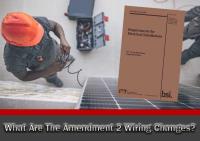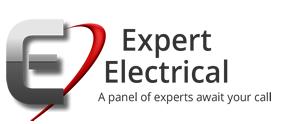 Add My Company
Add My Company
Sign In
What Are The Amendment 2 Wiring Changes?
30-06-2022

Amendment 2 of the 18th Edition IET Wiring Regulations (BS 7671:2018) recently came into effect on March 28, 2022. The previous version (BS 7671:2018+A1:2020) will be withdrawn six months later, on September 27 2022.
BS 7671:2018 is the most comprehensive set of standards that every electrical design and installation should refer to. But, as stated by British Standard Institution (BSI):
The Regulations apply to the design, erection, and verification of electrical installations, also additions and alterations to existing installations. Existing installations that have been installed in accordance with earlier editions of the Regulations may not comply with this edition in every respect. This does not necessarily mean that they are unsafe for continued use or require upgrading.
The Important bits
Amendment 2 is comprehensive, but below are the important bits:
New Terms Are Introduced in Part 2
Several definitions have been modified, with most new definitions relating to the latest chapter. The most important definitions are:
Consumer — an entity using electricity. This can be a business or a homeowner.
Producer — an entity generating electrical energy such as a solar PV system.
Prosumer — an entity that both consumes and produces electrical energy
PEI (Prosumer's Electrical Installation) — low voltage installations associated with a distribution network.
All Sockets Must have RCDs
Regulation 411.3.3 will be altered to put three instances where a Residual Circuit Device (RCD) is required:
On socket outlets up to and including 32A in locations where it's used by ordinary people, children, or disabled users.
On socket outlets up to and including 32A in other locations.
On mobile equipment not exceeding 32A for outdoor use.
New Methods for Determining Overvoltage protection
Regulation 443.4.1 has been amended to require protection against transient overvoltages. Protection must be in place where the consequence caused by the overvoltage can result in any of the following:
Serious injury to or loss of human life
Failure of a safety device
Significant financial or data loss
Surge Protection Devices
Surge Protection Devices (SPD) will be a requirement for any structure with fire alarm systems, emergency lights, or similar systems. Domestic electricians will now need to consider the cost of installing an SPD against the damage that can occur if they don't install one and make the customer aware of the potential consequences if surge protection is ignored.
Is Surge Protection a Requirement?
If a customer decides against using surge protection, likely due to the additional cost, the risk factors need to put into writing, detailing the potential injuries and damages that can occur without the use of an SPD. The document must then be signed by both parties, with the customer accepting ultimate liability.
Although the SPD is not a “MUST be” fitted device, it is seen as “good practise”to install one.
AFDDs conforming to BS EN 62606 shall be provided for single phase AC final circuits supplying socket outlets with a rated Current Not Exceeding 32A in the following:
Higher Risk Residential Buildings (HRRB) (over 18M high or in excess of 6 storeys)
Homes in Multiple occupation (HMO)
Purpose Built Student accommodation
Care homes
Technically Arc Fault Detection Devices (AFDDs) are only a requirement in the above 4 installations as listed in 421.1.7.
Additional Earthing Required for New Premises
Regulation 542.1.2. requires additional earthing (like foundation earthing) for new foundations. This would mean new builds will need to be provided with a means to embed electrodes to supplement the earthing system.
New Chapter on Prosumers
The new regulation has a new chapter on prosumers. This chapter addresses prosumers' low voltage electrical installation (PEI). It discusses systems that can produce and store energy and addresses using and delivering electricity locally.
This chapter discusses the requirements, design, build, and verification of all low-voltage electrical installations.
Why Are These Amendments Significant?
We have a new word, "prosumer," and requirements for Prosumer's Electrical Installations for the first time. PEI could be residential or non-residential properties connected to additional sources of supply and/or storage, i.e. PV or battery. Electricians are encouraged to read the IET Code of Practice for Electrical Energy Storage Systems, which provides greater depth and clarity concerning this evolving technology.
There is likely to be a proliferation of prosumer installations due to rising energy costs, the effort at the government level to support the installation of solar panels, and other forms of renewable energy sources. There is also the need to secure clean, efficient, zero-carbon energy systems. For example, homeowners may well be encouraged to install solar PV systems. The effectiveness of this system is maximized when installed alongside a battery. We are moving towards a "smart grid". The electrical energy will not flow one way –– from the power plant to the consumer. Instead, the producer and the consumer can be the same entity as the prosumer.
Nowadays, and in the years to come, we have and will continue to see the increase of many more prosumers, which means they are both producer and consumer simultaneously and the energy flow in their electrical switchboards are bidirectional.
As we all know, one of the main components of renewable energy sources and EVs, in general, is the batteries that require extraordinary attention when designing our electrical switchboard. In a DC, electrical safety is a crucial element, and it's not as easy to cope with as the AC system.
It's clear that the amendments to the 18th Edition BS7671:2018 will significantly impact future electrical installations. Amendment 2 is open to interpretation and seems like it’s aimed at preparing the electrical industry for more comprehensive circuit protection to be employed, with SPDs and AFDDs fitted as standard.
It’s looking likely that the 19th Edition or possibly an Amendment 3 will change the wording and make further enforcements. As always everything is open to interpretation but the installer should always use “good practise” to ensure an electrical installation meets the requirements of the IET Wiring Regulations. FuseBox have been way ahead of this amendment with their comprehensive range of circuit protection products and were one of the first manufacturers to introduce a consumer unit fitted with an SPD.
Thanks for reading and a special thanks to Robing at FuseBox for his input, we welcome any comments and feedback about this article.
For more information on What Are The Amendment 2 Wiring Changes? talk to Expert Electrical Supplies Ltd
Enquire Now
List your company on FindTheNeedle.

